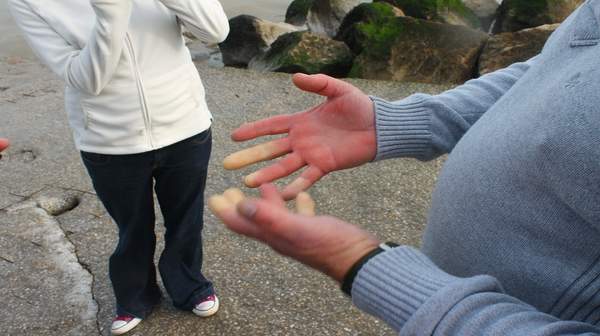What's in this article?
Hypothermia is a potentially dangerous drop in body temperature, usually caused by prolonged exposure to cold temperatures. The risk of cold exposure increases as the winter months arrive. But if you’re exposed to cold temperatures on a spring hike or capsized on a summer sail, you can also be at risk of hypothermia.
Normal body temperature averages 98.6 degrees. With hypothermia, core temperature drops below 95 degrees. In severe hypothermia, core body temperature can drop to 82 degrees or lower.
Hypothermia Causes
Normal body temperature is the reflection of a delicate balance between heat production and heat loss. Many of the chemical reactions necessary for human survival can occur only in specific temperature ranges. The human brain has a number of ways to maintain vital temperature. When these mechanisms are overwhelmed, heat loss happens faster than heat production, which results in hypothermia.
Primary hypothermia is due to exposure to a cold or frigid environment, with no underlying medical condition, causing disruption in temperature regulation:
The body loses heat by several major mechanisms that may occur at the same time.
- 55% go 65% is lost to the environment via radiation.
- Conduction only accounts for 2% to 3% in dry conditions, but this figure can increase to 50% if the victim is immersed in cold water.
- Convection accounts for 10%, while 2% to 9% is lost to heating inspired air.
- Twenty percent to twenty-seven percent is lost as a result of evaporation from the skin and lungs.
- Children cool quicker than adults because their skin provides a larger surface area compared to body mass.
The body also has a variety of methods to increase heat production. But at a certain low level, the body cannot continue heat production, and core body temperature drops quickly. From 98.6 F to 89.6 F (30 C to 32 C), the body begins to shiver, blood vessels contract, and hormones are released to facilitate the generation of heat.
- Shivering can increase heat generation about two to five times the normal body rate of 40 to 60 kcal per square meter of skin. However, this can only last a few hours under mild to moderate freezing conditions and far less in cold water immersion, the time depending on the water temperature and core body temperature. Eventually fatigue sets in, and the body exhausts its fuel stores.
- Blood vessels contract or narrow in the arms and legs, which allows warm blood to remain internal and somewhat protected from the cold temperatures to which the skin is subjected.
- Hormones and other small proteins are released in order to speed up the basal metabolic rate, essentially eating stored fuels in the hopes of producing heat as a byproduct.
Symptoms of hypothermia
The symptoms of hypothermia can vary depending on how low your body temperature has become.
The early symptoms of hypothermia are often recognised by a parent or carer. This is because it can cause confusion, poor judgement and changes in behaviour, which means the affected person may not realise they have it.
Mild hypothermia
If someone has mild hypothermia (generally with a body temperature of 32-35C), the symptoms aren’t always obvious, but they can include:
- constant shivering
- tiredness
- low energy
- cold or pale skin
- fast breathing (hyperventilation)
Moderate hypothermia
Moderate cases of hypothermia (generally with a body temperature of 28-32C) can include symptoms such as:
- being unable to think or pay attention
- confusion
- loss of judgement and reasoning (someone with hypothermia may decide to remove clothing despite being very cold)
- difficulty moving around
- loss of co-ordination
- drowsiness
- slurred speech
- slow, shallow breathing (hypoventilation)
People with a body temperature of 32C or lower will usually stop shivering completely. This is a sign that their condition is deteriorating and emergency medical help is required.
Severe hypothermia
The symptoms of severe hypothermia (a body temperature of below 28C) can include:
- unconsciousness
- shallow or no breathing
- a weak, irregular pulse, or no pulse
- dilated pupils
Someone with severe hypothermia may appear to be dead. However, under these circumstances they must be taken to hospital to determine whether they’ve died or if they’re in a state of severe hypothermia. Medical treatment can still be used to resuscitate people with severe hypothermia, although it’s not always successful.
Hypothermia in babies
Babies with hypothermia may look healthy, but their skin will feel cold. They may also be limp, unusually quiet and refuse to feed.
Hypothermia Treatment
The first priority is to perform a careful check for breathing and a pulse and initiate cardiopulmonary resuscitation (CPR) as necessary.
- If the person is unconscious, having severe breathing difficulty, or is pulseless, call 911 for an ambulance.
- Because the victim’s heartbeat may be very weak and slow, the pulse check should ideally be continued for at least one minute before beginning CPR. Rough handling of these victims may cause deadly heart rhythms.
The second priority is re-warming.
- Remove all wet clothes and move the person inside.
- The victim should be given warm fluids if he or she is able to drink, but do not give the person caffeine or alcohol.
- Cover the person’s body with blankets and aluminum-coated foils or other available protective covers (for example, a sleeping bag). Avoid actively heating the victim with outside sources of heat such as radiators or hot water baths. This may only decrease the amount of shivering and slow the rate of core temperature increase.
- Strenuous muscle exertion should be avoided; rubbing or massaging the limbs and exertion may trigger cardiac arrest in some hypothermic patients.
- Some cold exposure (borderline hypothermia), such as cold hands and feet, may be treated with home care techniques, but calling a health care professional for advise is recommended.






